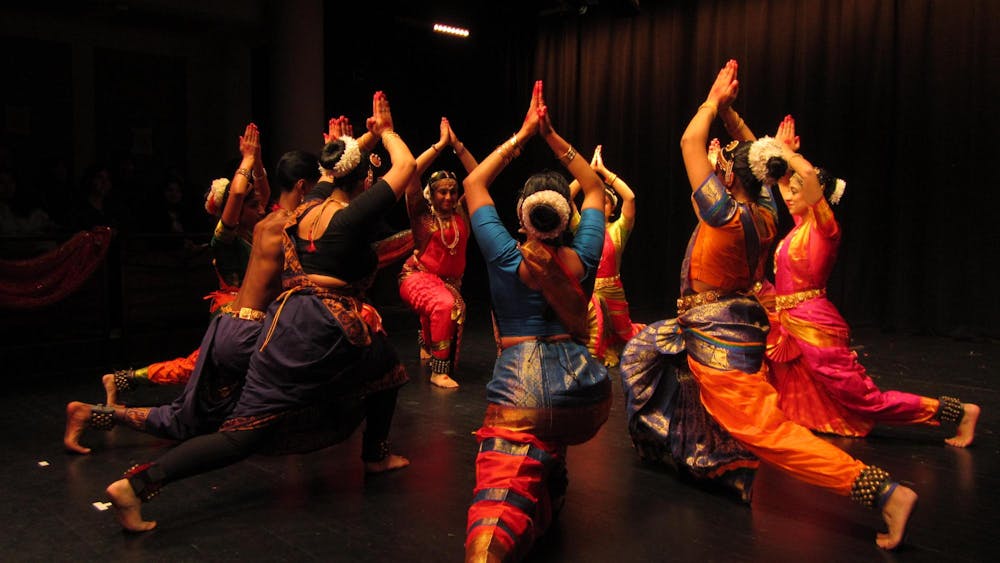On the small stage of the Class of 1970 Theatre in Whitman, dark blue lights flood the room. Four shadows emerge from stage right and step into view. The sounds of bells — attached to the dancers’ ankles — follow them as they walk. Gradually, the lights fade away, and the faces of the dancers emerge. As a melodic tune rings throughout the room, the dancers start rhythmically stomping their feet, holding flower petals in their hands.
This striking scene marks the opening of the new Kalaa dance troupe’s debut recital of the Bharatanatyam dance style. Bharatnatyam, also known as Rangapravesha, is a classical dance style that originated in South India and is now practiced worldwide. Being my first time attending a Bharatanatyam show, I wasn’t sure what to expect, but I was utterly amazed by the final result.
Before Kalaa officially started their debut performance, titled Pushpanjali, Treasurer Vaishnavi Murthy ’28 and Operations Chair Jaya Choudhary ’28 entered the stage with a brief introduction.
“In this dance, we give our salutations to Nataraja, the Hindu god of dance, our gurus, the musicians, and the audience. What makes this piece unique is the flower petals we carry in our hand throughout the dance as an offering to Nataraja,” Murthy explained.
As the performance began, the dancers rippled across the stage, their legs jingling with each shuffle, kick, and step. At one point, the four performers briefly stopped their dancing to deposit their flowers at the stage’s nearest point to the audience and resumed their dance seamlessly. The transitions and moves in the program were smooth, as every beat felt intentional and contributed to the performance.
Witnessing the sheer artistry of the performance, I was all the more surprised when Costume Chair Anika Mehrotra ’28 told me preparation for the show had only started two weeks earlier.
“[The show was] completely student-produced … We did one week of just teaching the pieces to everyone, and then the last week was just, grind, grind, grind,” Mehrotra told The Daily Princetonian.
Eventually, Pushpanjali progressed into the centerpiece of its repertoire and the fourth event overall: varnam, meaning “colors.” Mehrotra, Publicity Chair Laahini Addagatla ’28, and member Justin Shields ’25 then took a moment to introduce the piece, explaining the dialogue the dance represented.

“This particular varnam, titled Roopamu Joochi, praises the deity Sri Thyagaraja Swami, a particular form of Shiva who is well decorated with flowers and wears a golden thread across his chest,” Mehrotra explained. Shiva is a god in the Hindu trinity.
In the opening of Roopamu Joochi, two performers glided across the floor to the center of the stage. After a pause, the first two dancers exited in the same graceful fashion. When all four dancers exited, six new performers came into view, bursting into synchronized motions. With their energetic movements and joyful expressions, the dancers’ commendation of Sri Thyagaraja Swami was clear.
“We also portray some important stories about Shiva and how he protects the good and defeats evil,” Mehrotra continued. In one scene, a performer artfully mimed striking down another performer, emulating the deity Sri Thyagaraja Swami and eliminating a source of evil.
“Amidst all of this praising of Shiva, we as the narrators of the varnam also have a direct dialogue with Shiva, for despite his greatness, beauty, and protective nature, he appears to be personally indifferent to the Nayaki, the main female character — or in this case, characters played by all of us — who tells the story,” Addagatla said.

As varnam unfolded, I saw this narrative illustrated with the dancers’ steady and varied moves. Each dancer added a facet to the Nayaki, painting the story of a devoted follower longing for the love of her God.
Pushpanjali culminated in a mangalam, a piece in which the entire company paid respects to their teachers, gods, and audience. As the dancers moved fluidly in tandem, their chemistry was evident on stage. There were many moments when every dancer was on stage simultaneously, forming an amalgam of movement.
Mehrotra reflected this sentiment in her interview. “I definitely think this community is the most different thing you can get out of this kind of dance team," she said. “These people have been thinking about dance for, you know, years … getting to work with that kind of dedicated group of people and build that community is really nice.”
When asked about Kalaa’s future, Mehrotra said, “We definitely want to keep performing. We’re aiming to try one [show] per semester for future years, but I do think there might be a possibility of another this year.” Whether this year or the next, I am confident Kalaa will continue to highlight the extraordinary stories Bharatanatyam offers.
Princess Fodeke is a contributing writer for The Prospect from Valdosta, Ga.
Please send corrections to corrections[at]dailyprincetonian.com.








